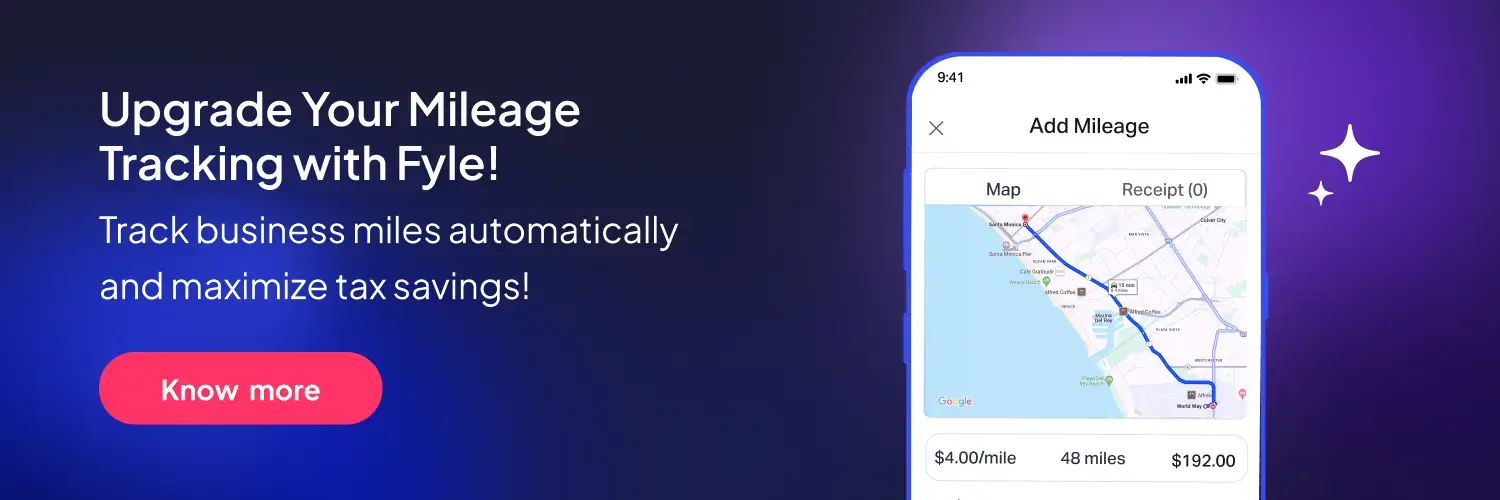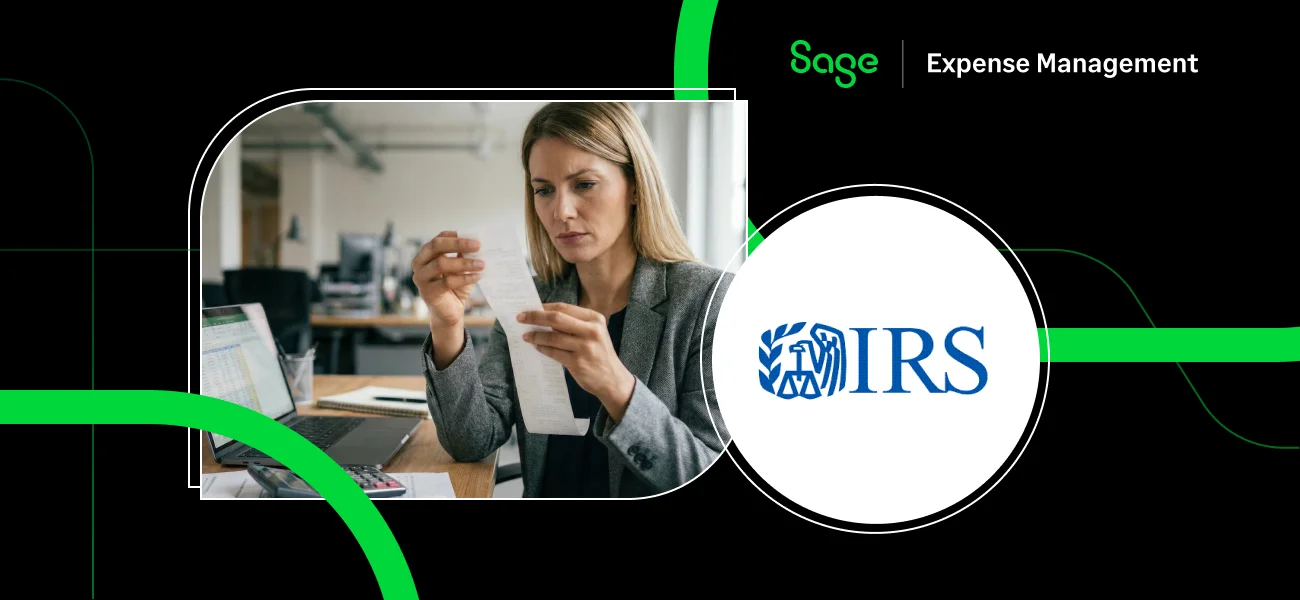Do your finance teams face challenges with tracking, validating, and approving mileage logs?
In a business, if an employee uses their personal vehicle for business errands, that employee needs to be compensated. Mileage tracking is crucial for both reclaiming expense reimbursements and for tax deduction purposes.
Reimbursement expenses include gas prices, insurance, registration fees, repairs, tire changes, and more. Employees must ensure they maintain trip records in a logbook or a spreadsheet. A detailed mileage log should include the date, start and end destinations, trip purpose, miles traveled, etc.
While this process can be time-consuming, can it always guarantee accuracy? A self-reported mileage log leaves finance teams unable to verify its correctness, opening up the possibility for errors or even fraudulent claims. For instance, employees could submit mileage for trips they never took.
In this article, we’ll explore how integrating Google Maps with your expense management software can make mileage tracking simple and secure.
What is Google Maps Mileage Tracking?
Google Maps mileage tracking leverages the accuracy of Google’s reliable navigation system to calculate distances between destinations. It provides an efficient way for businesses and individuals to track mileage, eliminating guesswork and manual entry.
Integrating Google Maps into expense management software helps businesses ensure accurate mileage tracking, improve transparency, and prevent potential errors or misreporting.
How to Track Mileage With Google Maps?
Google Maps is the most widely used and preferred navigation app worldwide due to its precise directions. It surpasses other GPS apps, offering seamless, real-time navigation. Google has invested in integrating its API into other platforms, making it an essential tool for expense management software.
Step-by-step guide for tracking mileage with Google Maps:
- Open Google Maps and enter your start and end destinations.
- Choose the best route, factoring in any stops or detours you may take.
- Once you’ve completed the trip, you can use the total distance for mileage reporting, either manually or via integrated expense management software like Sage Expense Management.
This integration simplifies the mileage reporting process and adds an extra layer of security.
Using Google Maps for Trip Planning and Mileage Estimation
Google Maps also doubles as a trip planner. It allows users to pre-plan routes and estimate mileage before embarking on a trip. This is especially useful for employees needing to submit mileage estimates for approval before traveling.
Trip planning features include:
- Adjusting for multiple stops.
- Reviewing real-time traffic conditions.
- Estimating travel times and distances.
Integrating Google Maps with an expense management system like Sage Expense Management automates this process and allows employees to submit accurate mileage logs based on planned or completed trips.
Tracking Mileage for Business Purposes
Tracking mileage accurately is essential for business purposes, especially when it comes to reimbursements and tax deductions. With Google Maps integrated into your expense management software, businesses can ensure mileage logs are accurate and comply with IRS guidelines.
Mileage tracking helps businesses:
- Comply with tax regulations.
- Ensure employees are reimbursed accurately for business trips.
- Prevent the risk of fraudulent mileage claims.
Also Read:
Automatic Mileage Rate Calculation
Traditional expense report templates often require manual data entry, which increases the chance of errors. For instance, employees manually calculating the distance between multiple stops can introduce inaccuracies, costing both time and resources.
With Sage Expense Management’s Google Maps integration, employees simply input their start and end points, and the software calculates the distance automatically. By eliminating manual calculations, businesses ensure accuracy while reducing the workload on both employees and finance teams.

Mileage Rate Based on Vehicle Type and Location
The IRS mileage rate varies depending on vehicle type. Whether your employees drive a two-wheeler or a four-wheeler, this difference must be accounted for when calculating reimbursements.
Sage Expense Management’s integration allows finance teams to set mileage rates based on vehicle type and location. Employees can select their vehicle type, and the software will automatically adjust the mileage rate accordingly. This ensures accuracy and compliance with IRS guidelines.
How to Maintain Mileage Logs Under One Tab
Traditionally, employees need to fill out numerous forms for mileage tracking, reimbursement, and tax deductions. This can result in cluttered paperwork, which is difficult to manage.
Sage Expense Management streamlines this process by organizing all mileage logs under one tab. Employees can enter mileage details quickly, and the logs are saved in the system. This not only saves time but also makes it easy for the finance team to review and approve mileage logs efficiently.
Google Maps vs. Dedicated Mileage Tracking Apps
While Google Maps is an excellent tool for mileage tracking, dedicated mileage tracking apps offer additional features designed for business purposes, such as automated expense reports and advanced integration with accounting software.
When to use Google Maps:
- For straightforward mileage tracking.
- For employees needing to track and report trips manually.
When to use dedicated mileage tracking apps:
- When businesses need advanced reporting, approval workflows, or automated syncing with accounting platforms.
- When tracking mileage for multiple vehicles or drivers.
Why Choose Sage Expense Management (formerly Fyle) for Business Mileage Tracking?
Sage Expense Management stands out as the best business mileage tracking app, enabling your employees to track and submit travel expenses directly from the everyday apps they use. With seamless integration into your finance workflows, it ensures accurate, automated mileage tracking, saving both time and effort for employees and finance teams alike.
Here’s why Sage Expense Management is the optimal choice for business mileage tracking:
Accurate Mileage Tracking Powered by Google Maps
%252520(1).webp)
Sage Expense Management integrates with Google Maps to streamline mileage tracking. Employees simply input their starting point, stops along the way, and the final destination. It will automatically calculate the distance traveled and accurately determine the mileage, eliminating errors and the need for manual calculations.
Configure Custom Mileage Rates and Fields
%252520(1).webp)
Finance teams can easily configure custom mileage rates based on vehicle types such as cars, trucks, or other vehicles. Sage Expense Management also allows for the creation of custom fields in the mileage form, enabling employees to provide detailed information for better tracking and reporting accuracy.
Manage Commute Deductions
.webp)
Sage Expense Management simplifies commute deductions by allowing employees to input their home and work locations, automatically calculating both one-way and two-way distances. Additionally, users can select from various commute deduction options, ensuring accurate, IRS-compliant mileage calculations. This feature can be made mandatory, guaranteeing policy adherence.
Set Up Recurring Miles
.webp)
For employees who regularly travel the same route, Sage Expense Management enables the setup of recurring mileage claims on a daily, weekly, or monthly basis. This feature eliminates the need for repetitive manual entry, streamlining the process and saving valuable time.
Enforce Policies and Ensure Compliance
Finance teams can create custom policies tailored to specific employee levels, departments, or unique fields. These policies can include constraints such as distance or amount limits, ensuring that each submitted mileage claim complies with IRS rules and company guidelines.
Robust Accounting Integrations
Sage Expense Management integrates seamlessly with your existing accounting software, automatically syncing business mileage and expense reports. This integration removes the possibility of manual errors and allows finance teams to focus on other critical tasks.
Reimburse Employees via ACH (US Only)
With Sage Expense Management, employers can directly reimburse employee mileage claims via ACH, ensuring timely payments and smooth financial operations.

Frequently Asked Questions
What’s The Most Accurate Way To Track Mileage Using Google Maps?
The most accurate method is to integrate Google Maps with an expense management system that automatically calculates mileage based on actual routes taken.
How Do I Export Mileage Data From Google Maps?
While Google Maps does not have a direct export option, you can use third-party apps or expense management software like Sage Expense Management to record and export mileage data.
Can I Track My Mileage Offline With Google Maps?
Yes, Google Maps allows you to download maps and navigate offline. However, you’ll need to log mileage manually or once you regain internet access.
What If I Need To Track Mileage For Multiple Vehicles Or Drivers?
Sage Expense Management supports multiple vehicles and drivers by allowing users to set up different profiles and manage logs for each vehicle under one system.
In Conclusion
Integrating Google Maps with your expense management software can significantly improve mileage tracking, reducing errors and preventing fraudulent claims. With Sage Expense Management, businesses can enjoy automated mileage rate calculations, easy log management, and reliable compliance with tax regulations.




.webp)
















